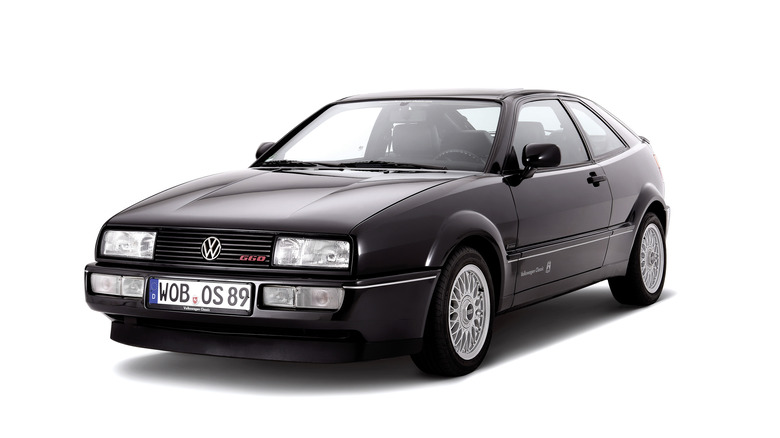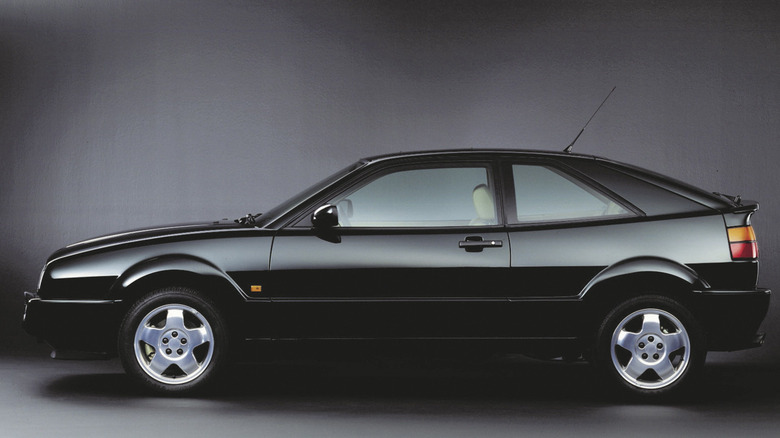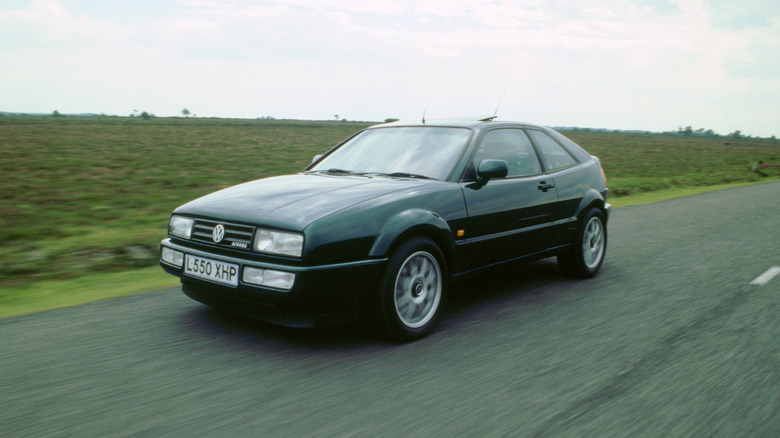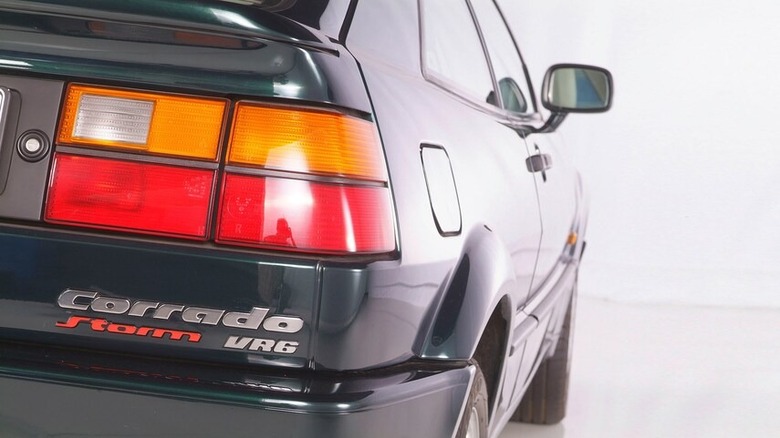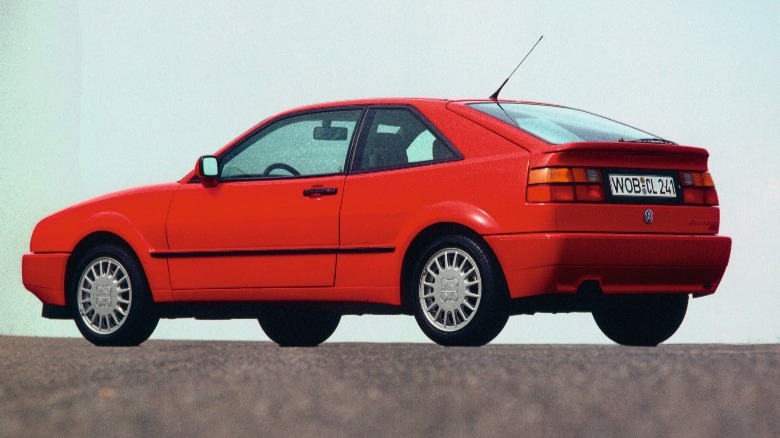The Ambitious Volkswagen That Never Cracked Into The American Market
German automaker Volkswagen's most iconic American imports have to be the Type 1 Beetle and the Golf/Rabbit, two of the best-selling nameplates in VW's history. VW sold over 23 million Beetles in a mightily impressive 81-year production run, while the current Mk 8 Golf GTI and Golf R remain the hot hatches of yore with powerful turbo engines in a fun-to-drive platform.
Special mention goes to the Scirocco, a sleeker and sportier Golf sold in two generations from 1975 to 1992. Unlike the Golf, VW's coachbuilder Karmann built the Scirocco in Osnabrück, Germany. Things weren't rosy as VW began working on the successor to the aging second-gen Scirocco. According to Car and Driver, the supposedly third-gen Scirocco grew so costly and advanced that VW brass decided to launch it as a separate model, and VW sold it alongside the Mk2 Scirocco in 1988.
Named after the Spanish verb "correr" or "to run" in plain ol' English, the VW Corrado is more than just a second-gen Golf in a glammed-up body style. The Corrado is a serious performance contender, and it came to market with some reasonable bragging rights.
VW Corrado: If looks could kill
Back in the 1970s to the mid-'80s, people knew Volkswagen as the maker of economical hatchbacks and sedans. However, the Corrado changed everything as it arrived at U.S. shores in 1990. It was still a front-wheel-drive, 2+2 hatchback like the Golf, but it was about 300 pounds heavier and rode on a longer and wider wheelbase.
Designed by VW's in-house design chief Herbert Schäfer, the Corrado's angular and chunky body style stood out against its rival, the Porsche 944. The sleeker shape gave it a lower 0.32 drag coefficient, better than the Porsche 944's 0.35 Cd. It also came with a fancy motorized rear wing that raises automatically at 45 mph while reducing rear lift by 64%. It also raises or lowers by pressing a switch, a feature that brought tears to the eyes of enthusiasts in the early '90s, and the Corrado is forever known as one of the first production vehicles in the U.S. to have active aero.
Furthermore, VW gave the Corrado an impressive list of performance-enhancing components like a close-ratio five-speed manual transmission, four-wheel disc brakes, independent suspension with Bilstein shock absorbers, and beefier anti-roll bars.
The VW Corrado's supercharged engine
The VW Corrado initially came with two 1.8-liter four-cylinder engines, a naturally-aspirated and supercharged variant, the latter found in the Corrado G60 sold from 1990 to 1992. Equipped with a G-Lader compressor or blower with intermeshed spiral fins that produce 10 pounds of boost, the Corrado G60 has 158 horsepower, 166 pound-feet of torque, and a delicious supercharger whine at full chat. It also came with a computer-controlled multi-point fuel injection system to produce an 8:1 compression ratio, helping propel the Corrado G60 from zero to 60 mph in 7.5 seconds and a 140 mph top speed according to a MotorWeek review.
According to Car Magazine, the Corrado G60 has more grip, has better traction, steers quicker, and corners better than the Porsche. It also has comfy and supportive seats to bring the perfect driving position, and it's relatively practical with 60/40 split-folding rear seats, a low liftover height, and up to 15.3 cubic feet of cargo room in the trunk.
VW Corrado SLC: Enter the VR6 engine
Volkswagen gave the Corrado a new yet compact 2.8-liter VR6 engine for 1992 and called it the SLC (Sport Luxury Coupe). Pumping out 179 horsepower and 177 pound-feet of torque, VW's unique VR6 motor is smoother and more refined than the best inline-six engines while piping out a more thrilling and engaging sound. With more power came more speed, and the Corrado SLC delivered by breaking zero to 60 mph in 6.4 seconds. It also gained an optional automatic gearbox that pushes the car to a still-impressive 7.8 seconds from zero to 60.
In addition, the Corrado SLC got a mild exterior refresh with a new hood, an updated four-bar grille, a new chin spoiler, clear front turn signals, and 15-inch five-lug domed-face BBS wheels. Later models got a revised Plus-Axle front suspension, a trunk-mounted CD changer, and side-impact protection. It also came standard with traction control, anti-lock brakes (ABS), new Koni shock absorbers, and full velour upholstery.
Unfortunately, the VW Corrado grew pricier over the years. What started as a sub-$18,000 sporty coupe grew to around $21,840 when the SLC model came in 1992. In its final model year in America, Corrado's base price was $25,150 in 1994, and Karmann only made 97,521 Corrados in seven years of production, not a lot compared to the 800,000 Sciroccos built from 1974 to 1992.
The final nail in the coffin was the VW Corrado's propensity for unreliability. The Corrado G60's G-Lader supercharger was highly unreliable, the ignition switch failed, and the motorized rear spoiler could blow multiple fuses over its lifespan. But with Porsche-shattering performance and pure driving feel, the VW Corrado is a sought-after collector's classic, but only for those who can live with the quirks.
